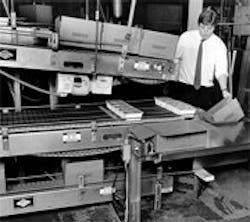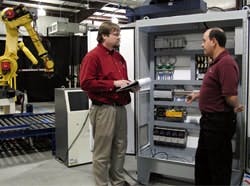Filler/Capper Machine Builder Follows Pharmaceuticals and Cosmetics Regulations
ESS Technologies (www.esstechnologies.com) in Blacksburg, Va., was founded in 1993 by Kevin and Linda Browne. Focused on engineering sales and service (ESS), it specialized in integrating packaging equipment from other OEMs. Before long, ESS began to design and manufacture its own line of monoblock filler/capper machines and other packaging equipment. ESS became an authorized system integrator for Fanuc Robotics in 2002 and began to integrate robotics automation into a number of products, including case packers, assembly systems, machine infeeds and palletizers.
ESS and its 23 employees build machines and equipment for a variety of industries with different needs and regulations.
"Pharmaceutical manufacturers differ from many industries simply because of the amount of regulation that their processes and products must adhere to," explains Walt Langosch, director of sales and marketing for ESS. "Often, the processes require Class 10,000 cleanroom technology. Cosmetics also require special handling, especially nail polishes and fragrances that might contain high levels of flammable liquids. ESS provides automated equipment that includes intrinsically safe controls to reduce fire risks in these types of installations."
The engineering team consists of mechanical engineers, electrical engineers, robotic engineers, CAD draftspeople and field service technicians. More than half of its employees are involved in the design and manufacture of its products, says Langosch.
"A typical system is comprised of a PLC, touchscreen HMI and servo controls," explains Mike Morgan, systems engineer. "We typically use Rockwell Automation products but have the capability to work with GE, Fanuc, Siemens, Omron and B&R Automation, to name a few. And we’re also an authorized Fanuc Integrator."
ESS usually works with PLC-based controls but does offer PC-based controls, depending on the system and the customer’s requirements. "We offer embedded control on some systems," says Morgan. "A typical example would be a system that uses a set of weigh scales and feedback from a servo-controlled filling pump to maintain an accurate fill weight."
ESS builds all robot systems to a Category 4 safety rating and all machine systems to a minimum of a Category 3 safety rating, says Morgan. "We also build all robotic cells according to RIA 15.06 safety standards, which are over and above OSHA standards."
New technologies in networking and communications drive innovation in design and automation at ESS, explains Morgan. "We see more devices that are capable of communicating on a common network," he says. "This can cut wiring time and increase the amount of information we can pull from that device. The trends that will make the biggest impact would have to be the availability of EthernetI/P devices and new technologies in robotics and servo motors. Our machine controls will change mainly based on the availability of more devices on the control network, which will allow us to pull in more information from each device for monitoring and troubleshooting and also will allow the user to make changes to device parameters without having to go to each device."
ESS offers start-up assistance and on-site training and provides training on integrated systems in conjunction with other OEM personnel, says Langosch. Fanuc Robotics also offers a number of training programs for the operation of its Handling Tool and Pallet Tool software, he explains.
"We also provide full after-sales support, including an in-house inventory for many spare parts," says Langosch. "All machine manuals include machine assemblies, spare-parts lists and bills of materials that list the commercial part numbers and manufacturers so ESS customers can obtain spare parts from ESS or source the parts themselves. In addition, we perform routine and preventive maintenance as an optional service."


